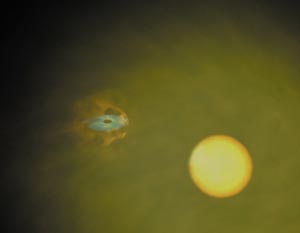
INTEGRAL, the powerful gamma-ray space telescope, has discovered what seems to be a new class of astronomical objects. These are binary systems, probably including a black hole or a neutron star, embedded in a thick “cocoon” of cold gas. They have so far remained invisible to all other telescopes.
This discovery was announced by the European Space Agency (ESA) on 17 October, just one year after the launch of the INTEGRAL satellite to study the most energetic phenomena in the universe (CERN Courier October 2002 p10). The first object of this new class, called IGR J16318-4848, was detected by INTEGRAL on 29 January 2003. Because of its similarity to other sources located along the plane of our galaxy, the Milky Way, astronomers concluded that the new object could be a binary system comprising a compact object, such as a neutron star or a black hole, and a companion star.
When gas from the companion star is accelerated and swallowed by the compact object, radiation is emitted at all wavelengths, from gamma rays through to visible and infrared light. About 300 such binary systems are known to exist in our galaxy and are well observed in X-rays, so why had IGR J16318-4848 not been discovered before?
One possible explanation is that it had remained invisible because it is heavily obscured by the surrounding material. As gamma rays are absorbed less by dust and gas than less energetic radiation this could explain why space telescopes that are sensitive to X-rays had overlooked the object, while INTEGRAL, which is specialized in detecting more energetic gamma-ray emission, did see it.
To test this interpretation, astronomers turned to ESA’s XMM-Newton space observatory, which observes the sky in X-rays. XMM-Newton detected IGR J16318-4848 last February, and the observations suggest the existence of a dense cocoon of cold gas with a diameter of about the size of the Earth’s orbit around the Sun. The obscuring material forming the cocoon is probably “stellar wind”, namely gas ejected by the supermassive companion star. Astronomers think that this gas may be accreted by the black hole, forming a dense shell around it. This obscuring cloud traps most of the energy produced inside it.
The main author of these results, Roland Walter of the INTEGRAL Science Data Centre in Switzerland, explained: “Only photons with the highest energies (above 10 keV) could escape from that cocoon. IGR J16318-4848 has therefore not been detected by surveys performed at lower energies, nor by previous gamma-ray missions that were much less sensitive than INTEGRAL.”
The question now is to find out how many of these objects lurk in the galaxy. XMM-Newton and INTEGRAL together are the perfect tools for the job. They have already discovered two more new sources embedded in obscuring material, and future observations are planned.
Further reading
R Walter et al. 2003 Astronomy and Astrophysics 411 L427.
Picture of the month

The solar X-ray flare of 4 November 2003 was the strongest recorded since the 1970s. The flare itself is seen here at the lower right of this dramatic extreme ultraviolet image of the Sun captured by the EIT camera aboard the SOHO spacecraft. The horizontal structure across the flare is due to pixel saturation. When this historic flare occurred, the giant sunspot region at its origin was just about to rotate around the Sun’s western edge, becoming hidden from our view for two weeks. (SOHO – EIT Consortium, ESA, NASA.)







